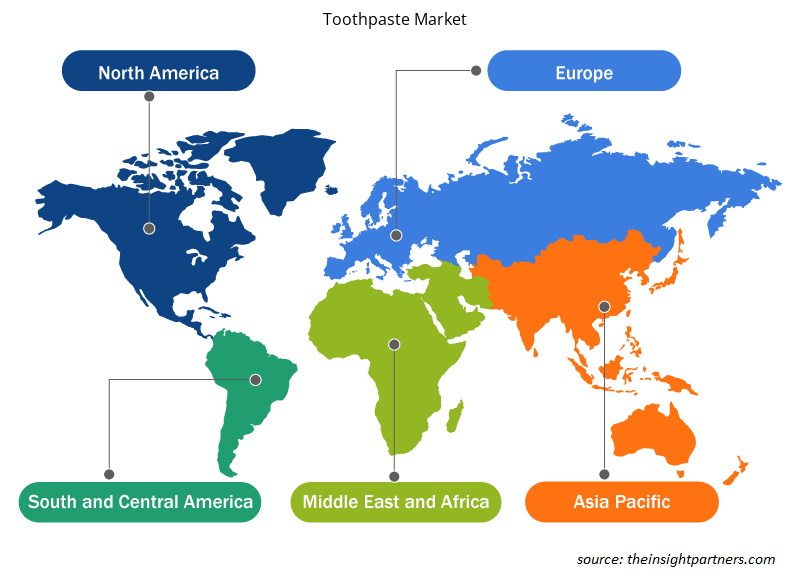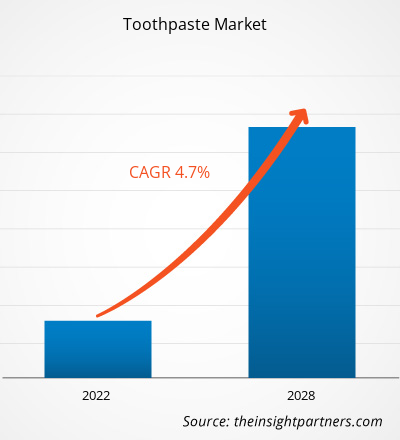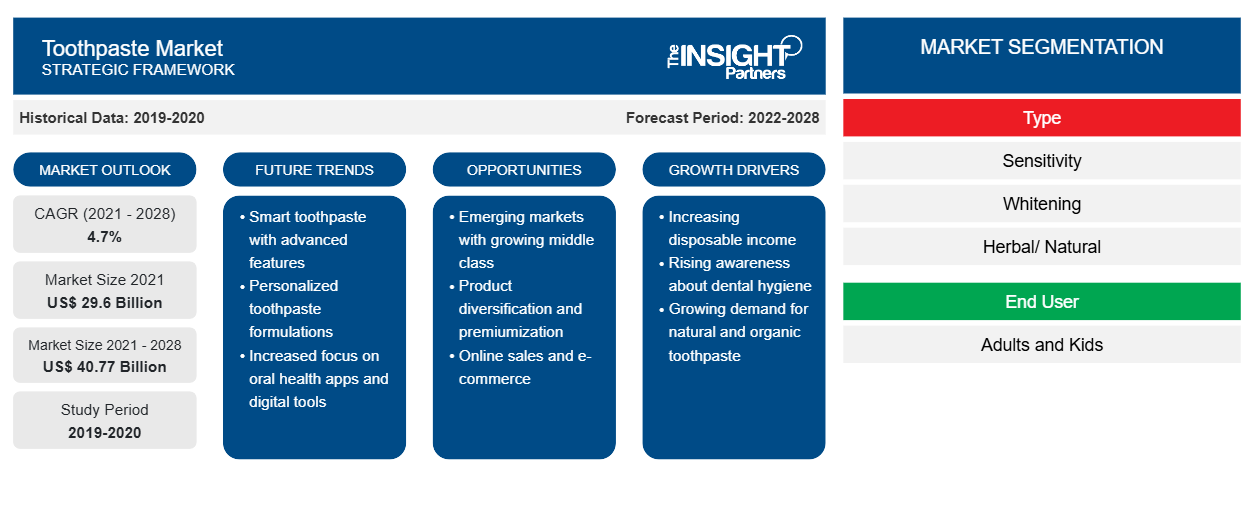[Rapport de recherche] Le marché du dentifrice était évalué à 29 598,97 millions USD en 2021 et devrait atteindre 40 766,21 millions USD d'ici 2028 ; il devrait croître à un TCAC de 4,7 % de 2021 à 2028.
En termes de volume, la demande mondiale de dentifrice devrait atteindre plus de 19 milliards d’unités d’ici 2028.
Un dentifrice est composé de plusieurs composants, les trois principaux étant les abrasifs, le fluor et les détergents. Le dentifrice est utilisé pour favoriser l'hygiène bucco-dentaire : c'est un abrasif qui aide à éliminer la plaque dentaire et les aliments, aide à supprimer la mauvaise haleine et fournit des ingrédients actifs (le plus souvent du fluor) pour traiter la carie dentaire et prévenir les maladies des gencives.
En 2020, l'Asie-Pacifique représentait la plus grande part du marché mondial du dentifrice . L'Amérique du Sud et l'Amérique centrale devraient enregistrer le TCAC le plus élevé au cours de la période de prévision. Le marché du dentifrice dans la région comprend plusieurs économies telles que l'Australie, l'Inde, la Chine, le Japon, la Corée du Sud et le reste de l'APAC . Les principaux facteurs qui stimulent le marché du dentifrice sont une base de clientèle solide, une prise de conscience croissante de la santé et de l'hygiène bucco-dentaires et des changements de mode de vie. En Inde, la sensibilité dentaire est très répandue. Il existe une forte demande d'offres basées sur les besoins dans la région, telles que le dentifrice traitant la sensibilité dentaire, le dentifrice blanchissant, le dentifrice à base de gel ou le dentifrice aux ingrédients à base de plantes et naturels. Ces catégories de dentifrice gagneront une part plus importante au cours des prochaines années. Il existe une forte demande de dentifrice aux saveurs différentes. Avec un changement marqué dans la demande des consommateurs pour le dentifrice naturel, le sous-segment naturel et à base de plantes du marché du dentifrice connaît une croissance plus rapide.
Personnalisez ce rapport en fonction de vos besoins
Vous bénéficierez d'une personnalisation gratuite de n'importe quel rapport, y compris de certaines parties de ce rapport, d'une analyse au niveau des pays, d'un pack de données Excel, ainsi que de superbes offres et réductions pour les start-ups et les universités.
-
Obtenez les principales tendances clés du marché de ce rapport.Cet échantillon GRATUIT comprendra une analyse de données, allant des tendances du marché aux estimations et prévisions.
La pandémie de COVID-19 a fortement affecté l'ensemble du secteur des soins personnels. Les détaillants de soins personnels sont contraints de donner la priorité uniquement aux produits essentiels tels que les aliments, les boissons et les produits d'hygiène personnelle tels que le dentifrice, les désinfectants et les savons, ainsi qu'à la réduction des tailles d'assortiment et des unités de gestion des stocks ( SKU ) d'autres catégories de produits telles que le dentifrice à base de plantes. Le confinement mondial , dû à la pandémie de COVID-19, a particulièrement influencé le comportement d'achat des consommateurs en façonnant leurs habitudes d'achat. En raison de l'épidémie, on observe un changement dans l'inclination des consommateurs vers les produits d'hygiène. De plus, la tendance des consommateurs vers des produits sans additifs ni produits chimiques toxiques a été un facteur critique qui a propulsé la demande de produits dentifrices à base de plantes pendant ce confinement . En raison du manque d'accessibilité des produits dentifrices à base de plantes dans les magasins de détail, les consommateurs se tournent vers les canaux de commerce électronique pour obtenir ces produits. Cependant, le manque de produits et les problèmes de logistique devraient produire un écart entre l'offre et la demande sur les plateformes en ligne.
Informations sur le marché
Problèmes dentaires chez les personnes gériatriques et pédiatriques
Le nombre croissant d’enfants souffrant de problèmes dentaires devrait alimenter considérablement la croissance du marché. Selon l’Organisation mondiale de la santé, en mars 2020, près de 530 millions d’enfants dans le monde souffraient de caries dentaires sur leurs dents primaires. En outre, la croissance de la population gériatrique accroît la demande de dentifrice, car cette tranche d’âge est très vulnérable à plusieurs problèmes dentaires tels que la carie dentaire, les maladies des gencives et la carie dentaire. Selon le ministère américain de la Santé et des Services sociaux, environ 1 enfant sur 5 (20 %) âgé de 5 à 11 ans a au moins une dent cariée non traitée. De plus, 1 adolescent sur 7 (13 %) âgé de 13 à 19 ans a au moins une dent cariée non traitée. En outre, presque tous les adultes (96 %) âgés de 65 ans ou plus ont eu une carie ; 1 sur 5 a une carie dentaire non traitée.
Informations sur les types
En fonction du type, le marché mondial des dentifrices est segmenté en dentifrices sensibles, blanchissants, à base de plantes/naturels, pour fumeurs et médicamenteux. Le segment du blanchiment a dominé le marché mondial des dentifrices en 2020. Le dentifrice blanchissant est conçu pour favoriser le blanchiment des dents. Ces dentifrices blanchissants peuvent blanchir légèrement les dents en éliminant les taches de surface des dents. Pour éliminer les taches de surface, les dentifrices blanchissants contiennent principalement des particules abrasives spéciales ou des produits chimiques qui polissent doucement les dents. La demande toujours croissante de dents plus blanches a entraîné une augmentation du marché des dentifrices blanchissants. Les marques qui proposent des dentifrices blanchissants comprennent Crest, Colgate, Toms of Maine et Arm & Hammer.
Les principaux acteurs du marché opérant sur le marché du dentifrice comprennent Procter & Gamble ; Unilever ; GlaxoSmithKline Plc . ; Colgate-Palmolive Company ; Henkel Ag & Company, KGAA ; 3M ; Sunstar Suisse S.A. ; Lion Corporation ; Beverly Glen Laboratories, Inc. ; et The Himalaya Drug Company.
Aperçu régional du marché du dentifrice
Les tendances et facteurs régionaux influençant le marché du dentifrice tout au long de la période de prévision ont été expliqués en détail par les analystes d’Insight Partners. Cette section traite également des segments et de la géographie du marché du dentifrice en Amérique du Nord, en Europe, en Asie-Pacifique, au Moyen-Orient et en Afrique, ainsi qu’en Amérique du Sud et en Amérique centrale.

- Obtenez les données régionales spécifiques au marché du dentifrice
Portée du rapport sur le marché du dentifrice
| Attribut de rapport | Détails |
|---|---|
| Taille du marché en 2021 | 29,6 milliards de dollars américains |
| Taille du marché d'ici 2028 | 40,77 milliards de dollars américains |
| Taux de croissance annuel moyen mondial (2021-2028) | 4,7% |
| Données historiques | 2019-2020 |
| Période de prévision | 2022-2028 |
| Segments couverts |
Par type
|
| Régions et pays couverts |
Amérique du Nord
|
| Leaders du marché et profils d'entreprises clés |
|
Densité des acteurs du marché du dentifrice : comprendre son impact sur la dynamique commerciale
Le marché du dentifrice connaît une croissance rapide, tirée par la demande croissante des utilisateurs finaux en raison de facteurs tels que l'évolution des préférences des consommateurs, les avancées technologiques et une plus grande sensibilisation aux avantages du produit. À mesure que la demande augmente, les entreprises élargissent leurs offres, innovent pour répondre aux besoins des consommateurs et capitalisent sur les tendances émergentes, ce qui alimente davantage la croissance du marché.
La densité des acteurs du marché fait référence à la répartition des entreprises ou des sociétés opérant sur un marché ou un secteur particulier. Elle indique le nombre de concurrents (acteurs du marché) présents sur un marché donné par rapport à sa taille ou à sa valeur marchande totale.
Les principales entreprises opérant sur le marché du dentifrice sont :
- Procter & Gamble
- Unilever
- GlaxoSmithKline Plc.
- Société Colgate-Palmolive
- Henkel Ag & Company, KGAA
Avis de non-responsabilité : les sociétés répertoriées ci-dessus ne sont pas classées dans un ordre particulier.

- Obtenez un aperçu des principaux acteurs du marché du dentifrice
Rapports en vedette
- Tendances industrielles progressistes sur le marché mondial du dentifrice pour aider les acteurs à développer des stratégies efficaces à long terme
- Stratégies de croissance des entreprises adoptées par les marchés développés et en développement
- Analyse quantitative du marché mondial du dentifrice de 2019 à 2028
- Estimation de la demande de dentifrice dans diverses industries
- Analyse PEST pour illustrer l'efficacité des acheteurs et des fournisseurs opérant dans l'industrie pour prédire la croissance du marché
- Développements récents pour comprendre le scénario concurrentiel du marché et la demande de dentifrice.
- Tendances et perspectives du marché, associées aux facteurs qui stimulent et freinent la croissance du marché du dentifrice
- Processus de prise de décision en comprenant les stratégies qui sous-tendent l'intérêt commercial concernant la croissance du marché mondial du dentifrice
- La taille du marché du dentifrice à différents nœuds du marché
- Aperçu détaillé et segmentation du marché mondial du dentifrice, ainsi que de sa dynamique dans l'industrie
- La taille du marché du dentifrice dans diverses régions avec des opportunités de croissance prometteuses
Le rapport comprend la segmentation du marché mondial du dentifrice comme suit :
Français En fonction du type, le marché mondial du dentifrice est segmenté en sensibilité, blanchiment (anti-caries et autres), à base de plantes/naturel, fumeurs et médicamenteux. En termes d'utilisateur final, le marché est segmenté en adultes et enfants. En fonction du type de base, le marché est segmenté en gel et sans gel. En fonction du canal de distribution, le marché est segmenté en supermarchés et hypermarchés, supérettes, vente au détail en ligne et pharmacies. Par géographie, le marché du dentifrice est largement segmenté en Amérique du Nord, Europe, Asie-Pacifique (APAC), Moyen-Orient et Afrique (MEA) et Amérique du Sud et centrale. Le marché en Amérique du Nord est en outre segmenté en États-Unis, Canada et Mexique. Le marché du dentifrice en Europe est en outre segmenté en Allemagne, France, Royaume-Uni, Italie, Russie et reste de l'Europe. Le marché de l'Asie-Pacifique est sous-segmenté en Chine, Inde, Japon, Australie, Corée du Sud et reste de l'Asie-Pacifique. Le marché du dentifrice au Moyen-Orient et en Afrique (MEA) est lui-même segmenté en Afrique du Sud, en Arabie saoudite, aux Émirats arabes unis et dans le reste de la région. Le marché de l'Amérique du Sud et de l'Amérique centrale est sous-segmenté en Brésil, Argentine, Chili, Colombie et dans le reste de l'Amérique du Sud et de l'Amérique centrale.
Profils d'entreprise
- 3M
- Procter & Gamble
- Unilever
- GlaxoSmithKline Plc.
- Société Colgate-Palmolive
- Henkel Ag & Company KGAA
- Sunstar Suisse SA
- La Société Lion
- Laboratoires Beverly Glen, Inc.
- La compagnie pharmaceutique Himalaya
- Analyse historique (2 ans), année de base, prévision (7 ans) avec TCAC
- Analyse PEST et SWOT
- Taille du marché Valeur / Volume - Mondial, Régional, Pays
- Industrie et paysage concurrentiel
- Ensemble de données Excel
Rapports récents
Témoignages
Raison d'acheter
- Prise de décision éclairée
- Compréhension de la dynamique du marché
- Analyse concurrentielle
- Connaissances clients
- Prévisions de marché
- Atténuation des risques
- Planification stratégique
- Justification des investissements
- Identification des marchés émergents
- Amélioration des stratégies marketing
- Amélioration de l'efficacité opérationnelle
- Alignement sur les tendances réglementaires























 Obtenez un échantillon gratuit pour - Marché du dentifrice
Obtenez un échantillon gratuit pour - Marché du dentifrice